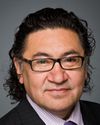It's very similar to that in that there are two distinct writing systems. The syllabic writing system is in place and used for some dialects or some communities of Cree and preferred in some areas versus alphabetic writing. When we talk about the alphabetic system, there are a number of different forms, some more directly adapted from English or French spelling. There is what we call optimistically the standard Roman orthography for Cree, which has been around for over 40 years now, following a meeting of western Cree speakers in Edmonton in 1973, which adopted a variation of a writing system that had been proposed decades earlier than that.
Much of the material that we try to produce here at First Nations University, the University of Alberta, and so on follows that writing system. There are materials that have been used or have been produced in these writing systems through most of the western dialects. The eastern dialects use a slightly different form for the most part. It's adaptable, but there are minor variations of it across the country. The western dialect is one.





